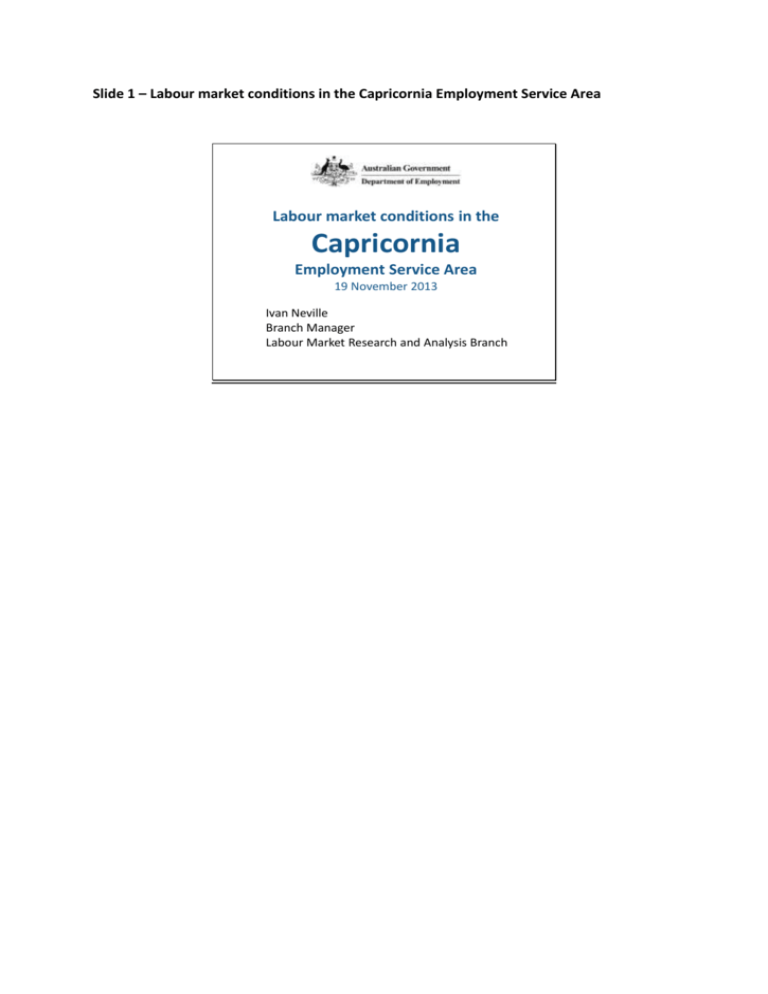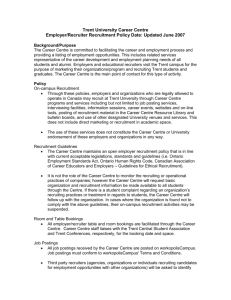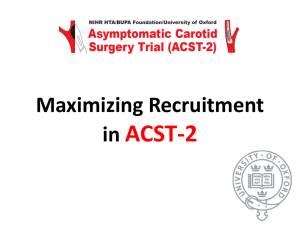DOCX file of Capricornia Employment Service Area
advertisement

Slide 1 – Labour market conditions in the Capricornia Employment Service Area Labour market conditions in the Capricornia Employment Service Area 19 November 2013 Ivan Neville Branch Manager Labour Market Research and Analysis Branch Slide 2 – Map of the Capricornia ESA Capricornia ESA and the Mackay-Fitzroy-Central West Labour Force Region Belyando Livingstone Peak Downs Capricornia ESA Mackay Mount Morgan Rockhampton Gladstone Fitzroy Emerald Rockhampton Bauhinia Woorabinda Mackay-Fitzroy-Central West LFR Duaringa Notes The Capricornia ESA is comprised of the following (2006) Statistical Local Areas (SLAs): • Bauhinia • Belyando • Duaringa • Emerald • Fitzroy Part A • Fitzroy Part B • Livingstone Part A • Livingstone Part B • Mount Morgan • Peak Downs • Rockhampton • Woorabinda For the sake of convenience, Local Government Area (LGA) names will be used throughout. Please note that in 2008, due to changes in LGA boundaries, the number of LGAs was reduced to four: Central Highlands, Isaac, Rockhampton and Woorabinda. However, only the Isaac – Belyando SLA within Isaac is within the Capricornia ESA. Both Isaac – Nebo and Isaac – Broadsound SLAs are outside of the ESA. Slide 3 – Profile of the Capricornia ESA Profile of the Capricornia ESA Adult Population Change Median age (15 +) (2011) (2006 to 2011) (Census) Bauhinia Belyando Duaringa Emerald Fitzroy Livingstone Mount Morgan Peak Downs Rockhampton Woorabinda Capricornia ESA Queensland Australia 1800 9700 5200 13,000 10,600 26,800 2500 2400 49,400 600 122,000 3,586,600 18,111,500 1400 -200 1500 2200 2600 -100 -100 100 7,400 330,400 1,464,000 36 30 31 31 33 41 45 30 35 22 35 36 37 Indigenous (% WAP) 2% 2% 5% 3% 4% 3% 11% 2% 6% 92% 5% 3% 2% Source: ABS, Population Estimates by Age and Sex, Regions of Australia, 2011; ABS, Census of Population and Housing, 2011 Notes Source: ABS, Population Estimates by Age and Sex, Regions of Australia, 2011; ABS, Census of Population and Housing, 2011. Capricornia ESA has seen modest adult population growth, of 6 per cent, over the five years to 2011. Across the ESA, median ages vary considerably, from 22 in Woorabinda to 45 in Mount Morgan. Slide 4 – Employment by industry Employment by industry Reliance on Mining Mining 13% 2% Health Care and Social Assistance 11% 12% 10% 11% Retail Trade Construction 8% Education and Training 8% 8% Accommodation and Food Services 9% Capricornia ESA Australia 7% 7% Manufacturing 6% Public Administration and Safety 6% 0% 9% 7% 5% 10% 15% Source: ABS, Census of Population and Housing, 2011 Notes Source: ABS, Census of Population and Housing, 2011. At the time of the 2011 Census, Mining and Health Care and Social Assistance were the largest employing industries in the Capricornia ESA. Slide 5 - Employment growth, 2006-11 Employment growth, 2006-11 Mining, Health Care and Social Assistance Mining 2700 Health Care and Social Assistance 1400 Construction 700 Professional, Scientific and Technical Services 500 Accommodation and Food Services 500 Manufacturing 100 Agriculture, Forestry and Fishing -200 -500 0 500 1000 1500 2000 2500 3000 Source: ABS, Census of Population and Housing, 2006 and 2011 Notes Source: ABS, Census of Population and Housing, 2006 and 2011 The Mining industry has seen the strongest employment growth over the five years to 2011. Slide 6 – Unemployment rate Unemployment rate Variation across the region Unemployment rate Annual change Rockhampton 7.7% 1.4% pts Emerald 2.8% 0.6% pts Fitzroy 4.8% 1.1% pts Livingstone 6.9% 1.8% pts Mount Morgan 24.0% 5.7% pts Capricornia 6.3% 1.4% pts Queensland* 5.9% -0.2% pts 5.7% 0.4% pts Australia* Source: Department of Employment, Small Area Labour Markets, June quarter 2013; *ABS, Labour Force, Australia, October 2013 (cat. no. 6202.0), seasonally adjusted data Notes Source: Department of Employment, Small Area Labour Markets, June quarter 2013; *ABS, Labour Force, Australia, October 2013 (cat. no. 6202.0), seasonally adjusted data There is considerable regional variation in the unemployment rate across Capricornia. The increase in Capricornia’s unemployment rate over the year suggests a softening in labour market conditions. Slide 7 – Many families jobless Many families jobless Jobless families with children under 15 Jobless families % of all families Rockhampton 970 16% Mount Morgan 110 45% Woorabinda 70 57% 1940 13% Queensland 62,170 14% Australia 294,880 14% Capricornia ESA Source: ABS, Census of Population and Housing, 2011 Notes Source: ABS, Census of Population and Housing, 2011 The incidence of jobless families in the Capricornia ESA compares well with the State and national averages. Some areas, however, have much higher rates of jobless families. Slide 8 – Income support Income support Some areas more dependant % Working age population (15-64) receiving Centrelink benefits Unemployment Parenting benefits payment Disability support Rockhampton 19% 6% 3% 7% Mount Morgan 48% 16% 6% 20% Capricornia ESA 15% 5% 3% 5% Queensland 17% 6% 3% 5% Australia 17% 5% 2% 5% Source: Department of Employment, Administrative Data, September quarter 2013; ABS, Population Estimates by Age and Sex, Regions of Australia, 2011 Notes Source: Department of Employment, Administrative Data, September quarter 2013; ABS, Population Estimates by Age and Sex, Regions of Australia, 2011 The Capricornia ESA had a smaller proportion of the working age population (WAP) who were in receipt of an income support payment (15 per cent) than the State and national averages (of 17 per cent). However, some areas had higher rates of income support, such as Rockhampton and Mount Morgan. Slide 9 – Teenage full-time unemployment Teenage full-time unemployment Teenage full-time unemployment rate Teenage full-time unemployment to population ratio (Oct-13) October 2013 Annual change Mackay-FitzroyCentral West LFR 23.2% 10.3% pts 9.0% Queensland 28.8% 4.6% pts 5.8% Australia 25.7% 1.6% pts 4.2% Source: ABS, Labour Force, Australia, Detailed – Electronic Delivery, October 2013 (cat. no. 6291.0.55.001), 12-month averages of original data Notes Source: ABS, Labour Force, Australia, Detailed – Electronic Delivery, October 2013 (cat. no. 6291.0.55.001), 12-month averages of original data While the teenage full-time unemployment rate was lower in the Mackay-Fitzroy-Central West LFR (which includes the Capricornia ESA) than the State and national averages, the teenage full-time unemployment to population ratio was considerably higher. Slide 10 – Many young people disengaged Many young people disengaged 20-24 year olds Not studying, not in the labour force Not studying, unemployed 25% 20% 15% 18% 10% 18% 6% 5% 7% 4% 6% 11% 6% 5% 4% 6% 4% 0% Male Female Rockhampton Male Female Capricornia Male Female Australia Source: ABS, Census of Population and Housing, 2011 Notes Source: ABS, Census of Population and Housing, 2011 The Capricornia ESA had higher rates of disengagement for 20-24 year olds than the Australian average. Slide 11 – Lower levels of educational attainment Lower levels of educational attainment 25-34 year olds 2011 Change since 2006 Advanced Diploma, Diploma, or Certificate III/IV Rockhampton 70% 4% pts 31% 22% Livingstone 65% 3% pts 35% 17% Mount Morgan 57% 13% pts 25% 7% Capricornia ESA 68% 4% pts 35% 19% Queensland 74% 6% pts 32% 29% Australia 75% 6% pts 30% 35% Year 12 or equivalent Bachelor Degree or higher Source: ABS, Census of Population and Housing, 2011 Notes Source: ABS, Census of Population and Housing, 2011 Year 12 attainment was slightly lower in the Capricornia ESA compared with the averages for Queensland and Australia. Slide 12 – Education and labour market outcomes Education and labour market outcomes 25-34 year olds 25% 100% 90.6% 89.6% 84.6% 78.7% 20% 19.6% Unemployment Rate (LHS) 15% 79.6% 71.1% 80% 60% Participation Rate (RHS) 10.9% 10% 40% 4.5% 5% 1.6% 1.3% Bachelor Degree or above Advanced Diploma/ Diploma Level 20% 2.5% 0% 0% Certificate III/IV Year 12 or equivalent Certificate I/II Below Year 12 Source: ABS, Census of Population and Housing, 2011 Notes Source: ABS, Census of Population and Housing, 2011 There is a strong relationship between educational attainment and labour market outcomes. People with higher levels of education are more likely to participate in the workforce, and less likely to be unemployed. Slide 13 – Indigenous labour market outcomes Indigenous labour market outcomes Indigenous Non-Indigenous Unemployment rate 16% 4% Participation rate 58% 70% • Indigenous unemployment rate four times the Non-Indigenous rate Source: ABS, Census of Population and Housing, 2011 Notes Source: ABS, Census of Population and Housing, 2011 This slide demonstrates the disparity in labour market outcomes for Indigenous and NonIndigenous Australians. Slide 14 – Improving Indigenous employment outcomes Improving Indigenous employment outcomes: Further develop skills Literacy and numeracy Further education and training 2% 29% Apprenticeships/ traineeships Further develop skills 3% 41% Soft skills/ general employability skills 6% Work experience 7% Source: Department of Employment, Survey of Employers’ Recruitment Experiences, July 2013 Notes Source: Department of Employment, Survey of Employers’ Recruitment Experiences, July 2013 Employers provided areas that could improve the employment prospects of Indigenous job seekers. Slide 15 – Improving Indigenous employment outcomes, continued Improving Indigenous employment outcomes: Provide employment assistance Incentives to business Third party liaison 1% 5% Mentoring program Provide employment assistance 3% 15% Incentives to work/ stay in work Advertising/ information about job opportunities 5% 3% Source: Department of Employment, Survey of Employers’ Recruitment Experiences, July 2013 Notes Source: Department of Employment, Survey of Employers’ Recruitment Experiences, July 2013 Employers provided areas that could improve the employment prospects of Indigenous job seekers. Slide 16 – Improving Indigenous employment outcomes, continued Improving Indigenous employment outcomes What employers have told us, continued “Greater access to training in regional areas for various industries” Source: Department of Employment, Survey of Employers’ Recruitment Experiences, July 2013 Notes Source: Department of Employment, Survey of Employers’ Recruitment Experiences, July 2013 Employers provided areas that could improve the employment prospects of Indigenous job seekers. Slide 17 – Staff change in the year prior to the survey Staff change in the year prior to the survey More employers decreased staff numbers due to economic reasons 30% Increased Decreased Decreased due to economic reasons 22% 20% 16% 10% 0% 9% -10% -20% 24% -20% -30% 2012 -27% 2013 Source: Department of Employment, Survey of Employers’ Recruitment Experiences, July 2013 and February 2012 Notes Source: Department of Employment, Survey of Employers’ Recruitment Experiences, July 2013 and February 2012 The 2013 survey results indicated that a larger proportion of employers had decreased staff numbers, especially due to economic reasons, compared with the 2012 survey. Slide 18 – Recruitment activity softer Recruitment activity softer… Summary survey results Capricornia 2013 Capricornia 2012 Past 12 months Average annual vacancies per 100 staff 22 32 Most recent recruitment round Unfilled vacancies 4.1% 12.7% Technicians and Trades Workers 13.5% 30.3% Average no. of applicants per vacancy 11.1 5.4 Recruitment expectations Expect to increase staff 20% 33% Source: Department of Employment, Survey of Employers’ Recruitment Experiences, July 2013 and February 2012 Notes Source: Department of Employment, Survey of Employers’ Recruitment Experiences, July 2013 and February 2012 Overall, the survey results suggest that recruitment activity has softened in the Capricornia ESA, compared with the 2012 survey. Slide 19 – But recruitment difficulty persists …But recruitment difficulty persists 49% of employers experienced difficulty in their most recent recruitment round Technicians and Trades Workers 51% Machinery Operators and Drivers Managers and Professionals 20% 68% Reasons for recruitment difficulty • Wages/contract/conditions (38%) • Technical skill requirements (27%) • Insufficient applicants (27%) • Location (31%) Source: Department of Employment, Survey of Employers’ Recruitment Experiences, July 2013, most recent recruitment round Notes Source: Department of Employment, Survey of Employers’ Recruitment Experiences, July 2013, most recent recruitment round Despite the softer recruitment conditions, employers still experienced some difficulty recruiting. Slide 20 – Opportunities still exist Opportunities still exist • Occupations that were most commonly mentioned as being difficult to fill: Sales Assistants (General) Chefs Early Childhood (Pre-primary School) Teachers Bar Attendants and Baristas Child Carers Real Estate Sales Agents Registered Nurses Motor Mechanics Cooks Accountants Source: Department of Employment, Survey of Employers’ Recruitment Experiences, July 2013 Notes Source: Department of Employment, Survey of Employers’ Recruitment Experiences, July 2013 A number of job opportunities might exist in occupations that employers noted as being difficult to fill. Slide 21 – Making the interview is the tough part Making the interview is the tough part Applicants per vacancy 11.1 Interviewed 3.2 Not interviewed 7.9 72% of applicants did not get an interview 12.4 in Rockhampton 7.6 elsewhere Unsuitable 1.6 Suitable 1.6 Source: Department of Employment, Survey of Employers’ Recruitment Experiences, July 2013 Notes Source: Department of Employment, Survey of Employers’ Recruitment Experiences, July 2013 A majority of applicants did not make it to the interview stage. Applicants who were interviewed, however, had about a 50 per cent chance of being rated suitable. Slide 22 – What is essential in an applicant What is essential in an applicant? Employability Skills 44% Qualifications 38% Experience Friendliness Communication People skills Reliability Confidence Enthusiasm 27% Technical Skills 13% Knowledge 6% 0% 10% 20% 30% 40% 50% • 1 in 5 applicants were excluded due to poor application Source: Department of Employment, Survey of Employers’ Recruitment Experiences, July 2013 Notes Source: Department of Employment, Survey of Employers’ Recruitment Experiences, July 2013 This slide demonstrates that employability skills, such as friendliness, confidence and reliability, were often considered essential by employers. Slide 23 – Informal recruitment popular Informal recruitment popular Applicants and suitability, by recruitment method Formal method 16 applicants, 4 interviewed 55% Informal method ONLY 4 applicants, 2 interviewed 45% Source: Department of Employment, Survey of Employers’ Recruitment Experiences, July 2013 Notes Source: Department of Employment, Survey of Employers’ Recruitment Experiences, July 2013 A large proportion of businesses opted to only use informal methods of recruitment, such as word of mouth, to fill their vacancies. Job seekers should therefore use a range of search methods when looking for a job. Slide 24 – Single greatest future concern Single greatest future concern Concerns about the economy weighing heaviest 60% 52% 50% 40% 30% 20% 12% 10% Recruitment or retention difficulty/ skill shortages No concerns 10% 0% Demand/ economy Recruitment expectations were subdued, although 47% of employers still anticipated recruiting • Recruitment expectations strongest in Accommodation and Food Services and Health Care and Social Assistance industries Source: Department of Employment, Survey of Employers’ Recruitment Experiences, July 2013 Notes Source: Department of Employment, Survey of Employers’ Recruitment Experiences, July 2013 Employers were most concerned about demand and the state of the economy in the future. Slide 25 - Conclusion Conclusion Labour market conditions have softened since 2012 • Recruitment activity has slowed • Rising unemployment Challenges • Tapering of mining investment and flow-on effects • Greater competition for vacancies • Indigenous; jobless families; youth disengagement; lower levels of education Opportunities • Recruitment still above average • Growth industries, such as Health Care and Social Assistance • Broad range of occupations difficult to fill • Some vacancies remain unfilled for Technician and Trades Workers occupations • Many vacancies advertised informally only Employability skills are essential Collaboration among key stakeholders Notes Labour market conditions have softened since 2012 • Recruitment activity has slowed • Rising unemployment Challenges • Tapering of mining investment and flow-on effects • Greater competition for vacancies • Indigenous; jobless families; youth disengagement; lower levels of education Opportunities • Recruitment still above average • Growth industries, such as Health Care and Social Assistance • Broad range of occupations difficult to fill • Some vacancies remain unfilled for Technician and Trades Workers occupations • Many vacancies advertised informally only Employability skills are essential Collaboration among key stakeholders Slide 26 – Further information For any questions about this presentation please contact the Recruitment Analysis Section on 1800 059 439 or email recruitmentsurveys@deewr.gov.au







